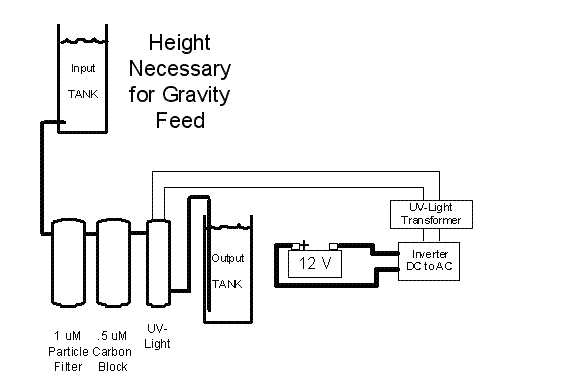
| |
 |
![]()
A handheld battery operated water sterilization UV-light is one way to kill off the living things in impure water while on the move in a primitive environment.
 SteriPEN™ specifications:
SteriPEN™ specifications:
It is highly portable and will last up to 35 liters (rechargeable) to 50 liters (one time use) of water on one set of batteries. A pre-particle filtering is
normally not included but would be recommended. For a description of one of the manufactures for this type of item see: http://www.steripen.com.
Typical price is between $75 and $130. Best way to find one is to search for "steripen" on eBay and product search engines.
The next step up in water purification would be to build the following: A gravity fed water purification minimum setup would have a 1 or 5 micron
particle filter, Carbon block .5 micron filter (removes 99+% of bacteria, some lead, iron and most of the hydrocarbons), and a UV-light at 1 GPM
in series with each other. The input bucket would be raised as high as necessary to provide a near 1 GPM flow. Depending on the carbon filter
this could be between 4 ft to 20 ft. A small say 60 or 100 watt inverter could be used to power the 6-10 watts needed for the UV-light to sterilize
the filter output water. The UV- light would kill the viruses and bacteria the made it through to that stage. To conserve battery one would hock up
the battery only when water is flowing. The following illustrates how this might look.

The best way to find a 6 watt 1 GPM UV sterilization light is to search for "uv water 1 gpm" or "uv water sterilizer". To find the carbon filter Search for "carbon block water filter .5 micron". If you can not easily find a .5 micron then use a 1 micron. A small 100 watt inverter can be picked up from harbor freight tools for less than $20.Note: If needed this can be made in to a relatively portable unit by using light weight components and plastic containers that fold up. Both of these methods would not work that well if there is a decent quantity of dissolved poisons like arsenic, cadmium, and mercury. The particle and carbon filter would reduce it however there is no guarantee the level would be low enough to be safe. A word of caution: Don't use the UV-light to put ozone in the water before running through a carbon filter. The carbon will take the Ozone out of solution. Use the UV-Light after filtering. The next stage to produce more quality would be to add a pressure pump and a reverse osmosis filter and a DI (demineralization) filter.
Offered by Mike.